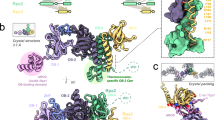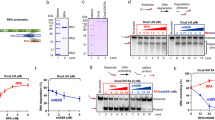Abstract
Human Replication Protein A (hsRPA) is required for multiple cellular processes in DNA metabolism including DNA repair, replication and recombination. It binds single-stranded DNA with high affinity and interacts specifically with multiple proteins. hsRPA forms a heterotrimeric complex composed of 70-, 32- and 14-kDa subunits (henceforth RPA70, RPA32, and RPA14). The N-terminal 168 residues of RPA70 form a structurally distinct domain that stimulates DNA polymerase α activity, interacts with several transcriptional activators including tumor suppressor p53, and during the cell cycle it signals escape from the DNA damage induced G2/M checkpoint. We have solved the global fold of the fragment corresponding to this domain (RPA70Δ169) and we find residues 8–108 of the N-terminal domain are structured. The remaining C-terminal residues are unstructured and may form a flexible linker to the DNA-binding domain of RPA70. The globular region forms a five-stranded anti-parallel β-barrel. The ends of the barrel are capped by short helices. Two loops on one side of the barrel form a large basic cleft which is a likely site for binding the acidic motifs of transcriptional activators. Many lethal or conditional lethal yeast point mutants map to this cleft, whereas no mutations with severe phenotype have been found in the linker region.
Similar content being viewed by others
References
Barbato, G., Ikura, M., Torchia, D. and Bax, A. (1992) Biochemistry,31, 5269–5278.
Braun, K.A., Lao, Y., He, Z., Ingles, J. and Wold, M.S. (1997)Biochemistry, 36, 8443–8454.
Brill, S.J. and Stillman, B. (1991) Genes Dev., 5, 1589–1600.
Brunger, A.T. (1992) X-PLOR: A System for X-ray Crystallographyand NMR, Yale University Press, New Haven, CT.
Erdile, L.F., Heyer, W.-D., Kolodner, R. and Kelly, T.J. (1991) J. Biol. Chem., 266, 12090–12098.
Fairman, M.P. and Stillman, B. (1988) EMBO J., 7, 1211–1218.
Farrow, N.A., Muhandiram, R., Singer, A.U., Pascal, S.M. and Kay, C.M. (1994) Biochemistry, 33, 5984–6003.
Firmenich, A.A., Elias-Arnanz, M. and Berg, P. (1995) Mol. Cell. Biol., 15, 1620–1631.
Georgaki, A., Strack, B., Podust, V. and Huebscher, U. (1992) FEBSLett., 308, 240–244.
Gomes, X.V. and Wold, M.S. (1995) J. Biol. Chem., 270, 4534–4543.
Grzesiek, S. and Bax, A. (1992a) J. Am. Chem. Soc., 114, 6291–6293.
Grzesiek, S. and Bax, A. (1992b) J. Magn. Reson., 96, 432–440.
Kanaar, R. and Hoeijmakers, J.H.J. (1998) Nature, 391, 335–337.
Kay, L.E. and Bax, A. (1990) J. Magn. Reson., 86, 110–126.
Kay L.E., Ikura, M., Tschudin, R. and Bax, A. (1990) J. Magn. Reson., 89, 496–514.
Kay, L.E., Keifer, P. and Saarinen, T. (1992) J. Am. Chem. Soc., 114,10663–10665.
Kay, L.E. (1993) J. Am. Chem. Soc., 115, 2055–2057.
Kraulis, P.J. (1991) J. Appl. Crystallogr. 24, 946–950.
Lee, S.E., Moore, J.K., Holmes, A., Umezu, K., Kolodner, R.D. and Haber, J.E. (1998) Cell, 94, 399–409.
Lin, Y., Chen, C., Keshav, K.F., Winchester, E. and Dutta, A. (1996)J. Biol. Chem., 271, 17190–17198.
Longhese, M.P., Plevani, P. and Lucchini, G. (1994) Mol. Cell. Biol.,14, 7884–7890.
Marion, D., Ikura, M., Tschudin, R. and Bax, A. (1989a) J. Magn. Reson., 85, 393–399.
Marion, D., Ikura, M. and Bax, A. (1989b) J. Magn. Reson., 84,425–430.
Marion, D., Kay, L.E., Sparks, S.W., Torchia, D.A. and Bax, A. (1989c) J. Am. Chem. Soc., 111, 1515–1517.
McCoy, M.A. and Mueller, L. (1992a) J. Am. Chem. Soc., 114,2108–2111.
McCoy, M.A. and Mueller, L. (1992b) J. Magn. Reson., 98, 674–679.
Muchmore, D.C., Mc Intosh, L.P., Russell, C.B., Anderson, D.E. and Dahlquist, F.W. (1989) Methods Enzymol., 177, 44–73.
Mueller, L. (1979) J. Am Chem. Soc., 101, 4481–4484.
Muhandiram, D.R. and Kay, L.E. (1994) J. Magn. Reson., B103,203–216.
Nicholls, A., Sharp, K.A. and Honig, B. (1991) Proteins Struct. Funct. Genet., 11, 281–296.
Pascal, S.M., Muhandiram, D.R., Yamazari, T., Forman-Kay, J.D. and Kay, L.E. (1994) J. Magn. Reson., B103, 197–201.
Richardson, J.S. (1981) Adv. Protein Chem., 34, 167–339.
Shaka, A.J., Keeler, J. and Freeman, R. (1983) J. Magn. Reson., 53,313–340.
Shaka, A.J., Barker, P. and Freeman, R. (1985) J. Magn. Reson., 64,547–552.
Umbricht, C.B., Erdile, L.F., Jabs, E.W. and Kelly, T.J. (1993) J. Biomol. Chem., 268, 6131–6138.
Umezu, K., Sugawara, N., Chen, C., Haber, J.E. and Kolodner, R.D. (1998) Genetics, 148, 989–1005.
Weisshart, K., Taneja, P. and Fanning, E. (1998) J. Virology, 72,9771–9781.
Wishart, D.S., Bigam, C.G., Yao, J., Abildgaard, F., Dyson, H.J., Oldfield, E., Markley, J.L. and Sykes, B.D. (1995) J. Biomol. NMR, 6, 135–140.
Wittekind, M. and Mueller, L. (1993) J. Magn. Reson., B101, 201–205.
Wobbe, C.R., Weissbach, L., Borowiec, J. A., Dean, F. B., Murakami,Y., Bullock, P. and Hurwitz, J. (1987) Proc. Natl. Acad. Sci. USA, 84, 1834–1838.
Wold, M.S. and Kelly, T. (1988) Proc. Natl. Acad. Sci. USA, 85,2523–2527.
Wold, M.S. (1997) Annu. Rev. Biochem., 66, 61–91.
Zuiderweg, E.R.P. and Fesik, S.W. (1989) Biochemistry, 28, 2387–2391.
Zhang, O., Kay, L.E., Olivier, P. and Forman-Kay, J.D. (1994) J. Biomol. NMR, 4, 845–858.
Author information
Authors and Affiliations
Rights and permissions
About this article
Cite this article
Jacobs, D.M., Lipton, A.S., Isern, N.G. et al. Human replication protein A: Global fold of the N-terminal RPA-70 domain reveals a basic cleft and flexible C-terminal linker†. J Biomol NMR 14, 321–331 (1999). https://doi.org/10.1023/A:1008373009786
Issue Date:
DOI: https://doi.org/10.1023/A:1008373009786




